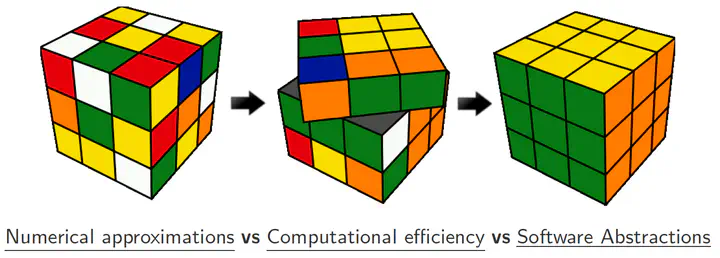RAMA

All physical phenomena involve inherently coupled processes. How to better reduce numerical modeling errors for such problems?
Scalable simulations of real-world coupled multiphysics problems are important for several mission-critical applications in climate, subsurface flow, nuclear engineering, fluid-structure interactions, astrophysics, and magneto-hydrodynamics to name a few. Such simulations require accurate solutions to large, stiff, nonlinear systems of equations to resolve variations in physical scales. The availability of large computing resources has allowed researchers to increase the fidelity of physical models and has simultaneously necessitated robust numerical schemes to achieve high degrees of efficacy (ratio of numerical accuracy over computational time). However, usage of a single numerical scheme involving iterated versions of explicit/semi-implicit operator splitting schemes, or monolithic (quasi-Newton, inexact-Newton variants) coupled solver to resolve scales of interest for the entirety of a simulation, based on a-priori physics knowledge can prove to be computationally suboptimal. The efficacy parameter dynamically evolves as a function of the spatiotemporal scales to be resolved, numerical schemes, problem regime, accuracy requirements, choice of programming models, and hardware architecture. To address these challenges, it is imperative to choose an approach that can dynamically select algorithms to reduce overall computational cost in scientific simulations, while preserving convergence to the true coupled, numerical solution for a variety of problems. Such an effort entails the development of a library implementing an array of different algorithmic options that can be used to solve coupled multiphysics problems optimally.
The design of the next-generation computational multiphysics solvers needs improved predictability and reduced time to the solution without sacrificing discretization accuracy. Such algorithms require
- adaptive discretization and solver methodologies that account for numeric approximations and transient problem regimes,
- scalable, load-balanced algorithms that optimally resolve stiff, nonlinear dependence between models with non-uniform memory access patterns on emerging architectures, and
- hierarchically composable implementations that solve strongly dependent model applications through plugin-based, loosely coupled software components.
To satisfy the growing needs of computational solvers, it is imperative to develop specific metrics of interest that can be used to dynamically drive algorithmic selection, and modify the runtime behavior of coupled multiphysics solvers, multimesh interpolation operators, temporal integration schemes, and domain repartitioning algorithms.